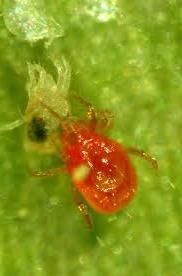Persimilis Phytoseiulus persimilis
Phytoseiulus persimilis (Persimilis) is a predatory mite which attacks spider mites Tetranychus urticae, (also known as red spider mite or two spotted mite) and bean red spider mites Tetranychus ludeni, in both protected and outdoor crops. Persimilis is most suited to moderate temperatures and high humidity, and is tolerant to some insecticides and most fungicides.
Description and biology
Persimilis is <1mm long, tear-shaped and orange to light red in colour. The female lays pale orange/pink round eggs usually on the back of leaves, and often in spider mite webs. Predator eggs are about twice the size of spider mite eggs. At 20°C it takes about 7 days for the predators to go from egg to adult, compared with nearly 15 days for the spider mites. This combined with a higher percentage of female predators, and a higher egg laying capacity than the pest, means that predator numbers will increase much faster than prey numbers in the right conditions. The larval stage has only 6 legs and does not feed (approx. 1 day) until it has moulted to the first nymphal stage (protonymph). Once the larva has moulted it has 8 legs, and feeding starts immediately. Adult predatory mites will feed on all stages of spider mite. The number of prey consumed depends on the predator and prey populations, the age of the predator, and the temperature and relative humidity. At approx. 20°C, an adult Persimilis can consume up to 5 adult spider mites or 20 young larvae or eggs per day. Adult female predatory mites can lay up to 5 eggs per day. In general, as the temperature increases, the number of prey consumed also increases up until 35°C. Higher temperatures and low humidity do not favour Persimilis. The optimal conditions for Persimilis establishment is between 15-25°C, and a relative humidity above 60%. In hot dry conditions, the predatory mites Typhlodromus occidentalis or Neoseiulus californicus may be better suited to controlling spider mites. Persimilis is almost entirely dependent on spider mites as food. Once their prey is depleted, predatory mite populations will decline in numbers. Plant density is important when first introducing predatory mites, as plants touching each other will help the predators to disperse through a crop more quickly.
Suitable crops
Persimilis can be used on a broad range of crops, both outdoors and in protected cropping situations. Suitable crops include strawberries, berry fruit, capsicums (sweet peppers), cucumbers, eggplants, tomatoes, hops, cut flowers (gerbera, rose, cymbidium orchids), grape vines, some tree crops and many ornamentals.
When to release
Persimilis works best when used preventatively, or when spider mites are first noticed in the crop. If spider mite numbers are already high it is advisable to use a non-disruptive miticide to lower the population prior to release. Residual broad spectrum insecticides should not be used for at least four weeks prior to or after release.
How to release
Persimilis is supplied in 500mL vented bottles containing 10,000 adults and nymphs in vermiculite (rather than on leaf material). This method of distribution is cheaper to transport, quick to distribute and has the advantage of being able to supply pure predatory mites without other insect/mite contaminants or plant diseases. Vermiculite is sprinkled over the plants targeting ends of rows and any known hotspots. If you are unable to release the predators immediately, bottles may be stored at 4-8°C for 1-2 days.
Release rates
Rates will vary depending on the crop and infestation level. Contact Biological Services for crop-specific recommendations. In general for greenhouse crops release rates can vary between 5-20 bottles per hectare (low-moderate infestation) with higher numbers needed for hotspots. Several releases a few weeks apart are recommended during the season. For outdoor strawberry crops, release at one bottle per 10,000 plants, 2-3 times, several weeks apart. Extra predators will be needed for mite hotspots.
Chemical use
Persimilis is tolerant to some insecticides but is still sensitive to those with long residual actions, particularly pyrethroids, organophosphates and neonicotinoids. Residues on foliage may remain toxic for many weeks and negatively impact on their survival and ability to effect control. Check side-effects charts carefully and avoid using pesticides before and during Persimilis use unless they are known to be safe. Contact Biological Services for specific information.
Ordering and accounts
Orders are sent via express courier services on Monday or Tuesday of each week, and usually arrive within a couple of days. Orders received after noon on Tuesday are sent the following Monday. Freight is charged at cost.
Accounts are sent at the end of each month, and can be paid by EFT, BPay, cheque or postal order.

Related pests
Related crops
- Beans
- Berryfruit
- Flowers/ornamentals
- Greenhouse capsicums
- Greenhouse cucumbers
- Greenhouse eggplants
- Greenhouse tomatoes
- Herbs
- Hops
- Melons
- Nursery
- Strawberries
- Tree crops







